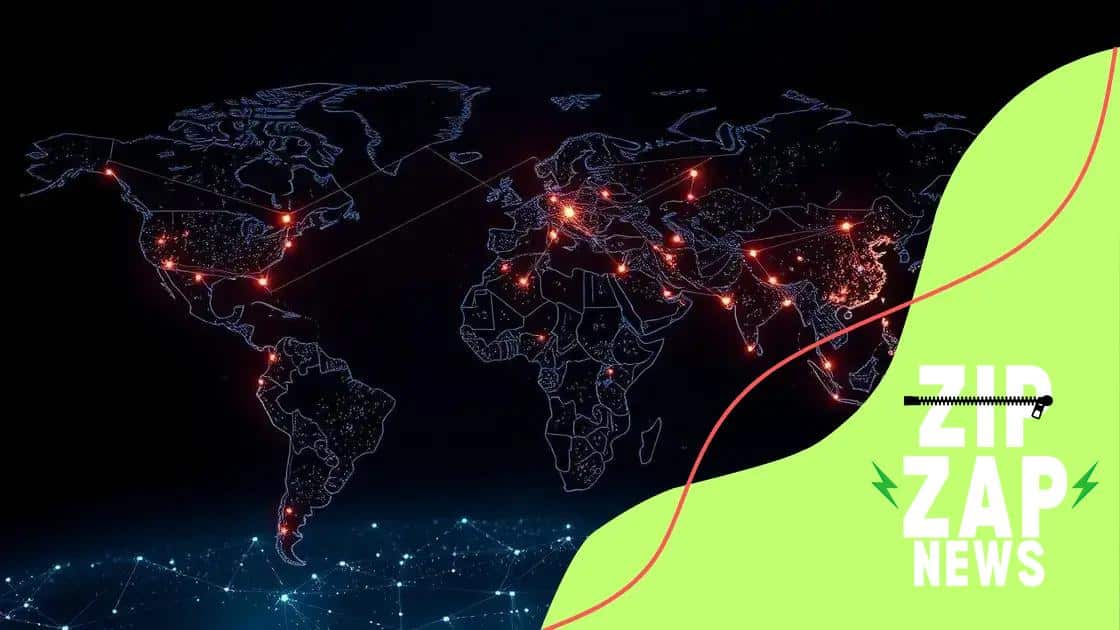Blockchain for cross-border payments: unlocking global finance

Blockchain technology is transforming cross-border payments by providing faster transactions, lower fees, increased security, and greater accessibility for businesses and consumers worldwide.
Blockchain for cross-border payments is changing the way we think about money transfers across borders. This technology promises to make transactions faster, cheaper, and more secure. Have you ever wondered how this could affect your global business operations?
Understanding blockchain technology
Understanding blockchain technology is essential to grasp its implications for finance and cross-border payments. This technology allows secure, transparent transactions without the need for intermediaries.
What is Blockchain?
At its core, a blockchain is a decentralized ledger that records all transactions across a network of computers. Each block contains a list of transactions and is linked to the previous block, forming a chain.
Key Features of Blockchain
- Decentralization: Control is distributed among all participants to ensure data integrity.
- Immutability: Once recorded, transactions cannot be altered, providing a secure audit trail.
- Transparency: All participants have access to the same information, promoting trust among users.
- Security: Advanced cryptography protects data from unauthorized access.
In finance, these features enable faster and safer cross-border payments. Conventional methods can take days and come with high fees. Blockchain, however, can cut transaction times to minutes and minimize costs.
Moreover, the technology removes reliance on third-party banks and financial institutions. This shift not only empowers individuals but can also facilitate micropayments that were previously unfeasible.
As businesses adopt blockchain, they gain a competitive edge. They can streamline operations and enhance customer experiences through faster processing times and lower transaction costs. The future of cross-border payments looks promising with blockchain, driving innovation and efficiency in global finance.
Advantages of blockchain for cross-border payments
The advantages of blockchain for cross-border payments are transforming the financial landscape. This technology provides enhanced efficiency and security, which benefits both individuals and businesses. With blockchain, traditional barriers to cross-border transactions can be overcome.
Cost Efficiency
One of the significant benefits of using blockchain is cost savings. Traditional cross-border payments often involve high fees due to intermediaries. Blockchain significantly reduces these costs by eliminating middlemen, making transactions cheaper for consumers.
- Lower transaction fees: Unlike conventional methods, blockchain fees are minimal.
- No hidden charges: Users are clearly informed about costs upfront, preventing surprises.
- Fast transfers: Transactions can be completed in minutes rather than days.
Another advantage is improved security. Blockchain technology provides a secure environment for transactions through encryption and decentralization. Because records are immutable, it’s incredibly difficult for malicious actors to alter transaction data.
Additionally, transparency in blockchain enhances trust among participants. Each transaction is recorded on a public ledger, allowing users to verify transactions independently. This feature is particularly beneficial in reducing fraud and increasing accountability.
Furthermore, the simplicity of using blockchain can enhance user experience. Participants in cross-border payments can send and receive money without navigating complex banking systems. This ease of use encourages broader adoption and accessibility.
Finally, blockchain enables greater financial inclusion. People in developing countries, often excluded from traditional banking systems, can access financial services through this technology. By enabling individuals to transact directly, blockchain empowers these populations economically.
Key challenges in implementing blockchain solutions

Implementing blockchain solutions comes with its own set of challenges that organizations must navigate. Understanding these key challenges can help businesses prepare and strategize effectively.
Regulatory Uncertainty
One major challenge is the lack of clear regulations surrounding blockchain technology. Many countries still have evolving laws, making it difficult for companies to ensure compliance.
Technical Complexity
The technical aspects of blockchain can be complex. Developing and integrating blockchain solutions often requires specialized knowledge and skilled personnel.
- Learning Curve: Companies need to invest time and resources into training staff.
- Integration Issues: Existing systems may not easily integrate with new blockchain technologies.
- Scalability Challenges: Many blockchain networks face issues handling large volumes of transactions efficiently.
Additionally, the perception of blockchain as a new and disruptive technology can lead to resistance from employees and stakeholders. Overcoming this skepticism is crucial for successful implementation.
Security concerns also pose significant challenges. Although blockchain is generally secure, vulnerabilities can still exist, particularly in smart contracts and wallet management. Ensuring robust security measures is essential to build trust among users.
Another aspect to consider is the cost involved in deploying blockchain solutions. Initial setup costs can be high, requiring investments in technology and human resources. Organizations must weigh these costs against potential long-term benefits to make informed decisions.
Lastly, the operational impact during the transition period can create disruptions in regular business activities. Proper planning and gradual implementation are vital to minimize interruptions.
Real-world applications of blockchain in finance
Real-world applications of blockchain in finance are vast and growing rapidly. Businesses are beginning to recognize the potential of this technology to reshape the financial landscape.
Smart Contracts
One major application is the use of smart contracts. These are self-executing contracts with the terms written directly into code. They automatically enforce and execute agreements based on predefined conditions.
- Automation: They reduce the need for intermediaries, making transactions faster and more efficient.
- Reduced Costs: By eliminating additional fees, smart contracts save money on both ends of a transaction.
- Increased Trust: Because they operate on a decentralized network, users can trust that the contract’s terms will be honored.
Another significant application is cross-border payments. Traditional methods can take days and cost a lot, but using blockchain technology can expedite this process. It allows for near-instantaneous transactions across borders with lower fees.
In addition, blockchain is being used for identity verification in the financial sector. With blockchain, personal identification can be securely stored, helping to prevent identity theft. This application enhances financial services by allowing quicker and more secure customer onboarding.
Furthermore, asset tokenization is transforming how investments are made. Real-world assets like real estate and art can be tokenized and sold as fractional shares, making them more accessible to a broader audience. This process democratizes investment opportunities that were once available only to the wealthy.
The integration of blockchain technology into finance also fosters enhanced transparency. All transactions are recorded on a public ledger that is visible to all participants. This openness helps reduce fraud and fosters accountability among users.
Future trends in cross-border payments with blockchain
The future trends in cross-border payments with blockchain are promising and full of potential. As technology evolves, we can expect significant changes in how money is transferred globally.
Increased Adoption of Digital Currencies
One major trend is the rising use of digital currencies. Countries are creating their own central bank digital currencies (CBDCs) to facilitate efficient cross-border payments.
- Faster Transactions: CBDCs can enable quick transactions between borderless banking systems.
- Lower Costs: Digital currencies may help reduce transaction fees significantly.
- Regulatory Compliance: CBDCs can integrate compliance measures within their architecture, ensuring legal standards.
Furthermore, partnerships between financial institutions and blockchain technology providers are becoming more common. These collaborations aim to streamline the payment process and improve security.
Another emerging trend is the use of blockchain for trade finance. By leveraging blockchain, businesses can track shipments, verify documents, and process payments more efficiently.
Moreover, enhanced interoperability between different blockchain networks is expected. This development will allow smoother transaction flows between various systems, making it easier for businesses to operate internationally.
Artificial intelligence will also play a crucial role in analyzing transaction data on blockchain platforms. Through AI, patterns can be detected, and risks can be identified, improving overall security for cross-border payments.
Additionally, as awareness increases, more small to medium-sized enterprises (SMEs) will likely utilize blockchain for cross-border transactions, broadening access to global markets.
Ultimately, the evolution of blockchain technology will redefine how we approach cross-border payments, delivering greater efficiency, security, and accessibility.
Conclusion
In conclusion, blockchain technology is revolutionizing the landscape of cross-border payments. Its ability to provide cost savings, enhanced security, and greater efficiency makes it an appealing option for businesses. As digital currencies and partnerships continue to grow, we will see an increase in the adoption of blockchain solutions. The future trends indicate a more interconnected financial system that benefits companies and consumers alike. Moreover, smaller enterprises can leverage these advancements, thus broadening their market access. Ultimately, blockchain is poised to transform how we think about and execute international transactions.
FAQ – Frequently Asked Questions about Blockchain for Cross-Border Payments
What is blockchain technology?
Blockchain is a decentralized digital ledger that records transactions across many computers, ensuring security and transparency.
How does blockchain improve cross-border payments?
Blockchain enables faster transactions with lower fees, eliminates intermediaries, and enhances the security of payments.
What role do digital currencies play in cross-border payments?
Digital currencies, especially central bank digital currencies (CBDCs), can simplify and speed up cross-border transactions while reducing costs.
What are the future trends of blockchain in finance?
Future trends include increased adoption of digital currencies, enhanced interoperability between systems, and greater access for small and medium enterprises.





